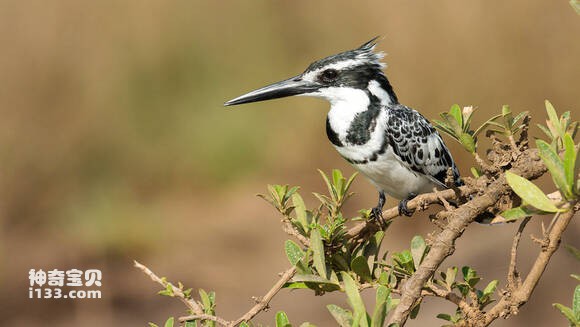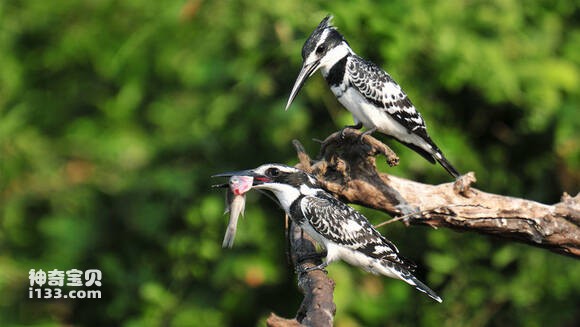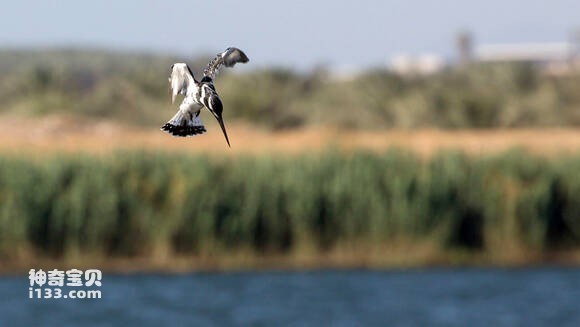Ceryle rudis
IUCN
LCBasic Information
Scientific classification
- name:Ceryle rudis
- Scientific Name:Ceryle rudis,Pied kingfisher
- Outline:Climbing birds
- Family:
Vital signs
- length:27.3-28.6cm
- Weight:100-130g
- lifetime:No textual research information is available
Feature
The appearance is very similar to the crested fish dog, the whole body is black and white spots, but the body size is small, and the crown feathers are shorter
Distribution and Habitat
It is distributed in Eurasia and northern Africa (including the whole of Europe, Africa north of the Tropic of Cancer, the Arabian Peninsula and Asia north of the Himalayas -- Hengduan Mountains -- Minshan Mountains -- Qinling Mountains -- Huai River), central and southern Africa (including the southern Arabian Peninsula and the whole African continent south of the Tropic of Cancer in the Sahara Desert), The Indian subcontinent and the southwest of China (including India, Bangladesh, Bhutan, Sikkim, Nepal, Pakistan, Sri Lanka, Maldives and the southeast of China's Tibet, etc.), Indochina Peninsula and the southeast coastal areas of China (including Myanmar, Vietnam, Laos, Cambodia, Thailand and the southeast coastal areas of China, Hong Kong and Hainan Island).
The spotted fish dog mainly lives in the low mountains and plain streams, rivers, lakes, canals and other open water banks, and sometimes even appear in ponds and roadside canals.
Appearance
The forehead, crown, crown and side of the head of the male bird are black with white stripes; Eye first and brow stripe white. The posterior neck is black and white, with a large white spot on each side of the neck. The back, shoulders and two wings are black, with white end spots, forming black and white mottled. The feathers are dark brown, the primary feather base is white, and the wings form a prominent white spot. In addition to white spots on the base and end of the medial secondary feathers, there are also white spots on the outer edges. White covering on waist and tail, with black subterminal spots. Tail white, with broad black subterminal spots. The lower body is white, and the chest has two black chest straps, one of which is wider in the front and narrower in the back. There are black spots on both hypochondrium and ventral sides.
The female is similar to the male, but has only one breast band, often broken in the middle, and only large black spots on both sides of the b
Details
Ceryle rudis, Pied kingfisher, has four subspecies (1. The common subspecies Ceryle rudis insignis2. Ceryle rudis leucomelanurus3. Ceryle rudis rudis4. Ceryle rudis travancoreensis, Indian subspecies of the Spotted fish dog.

Spotted fish dogs live in pairs or groups in large water bodies and mangroves. They are noisy and are the only fish dogs that often linger over the water to hunt for food. More than a few meters from the surface of the water to ten meters of low flying foraging, sometimes close to the water, sometimes rising, back and forth wings fly. As soon as they see the fish, they converge their wings, plunge into the water, and then rise sharply again. Rest on trees near the water, especially on dead trees and rocks, or rocks and branches protruding from the water. At the same time, watching the water, a fish found, immediately rushed into the water to hunt. The food is mainly small fish, and eats crustaceans and a variety of aquatic insects and their larvae, but also pecks at small frogs and a few aquatic plants. The cry is a high-pitched whistle.

The breeding period of the spotted fish dog is from March to July. During the breeding season, they will constantly sing and fiercely defend their nests and mates. Usually nest on the river bank sandstone, dig their own holes for the nest, without any internal cushion, each clutch of 3-6 eggs, mostly 4-5 eggs. Oval white, oval or oblong oval, size 28-32×23-25 mm, average 30×24 mm. Male and female birds incubate their eggs in turn. The chicks are late sex, and after hatching their eyes are blind, but after five days they can see and grow feathers.

Listed on the International Union for Conservation of Nature (IUCN) 2012 Red List of Threatened Species ver 3.1 - Not Threatened (LC).
Protect wild animals and eliminate wild meat.
Maintaining ecological balance is everyone's responsibility!








